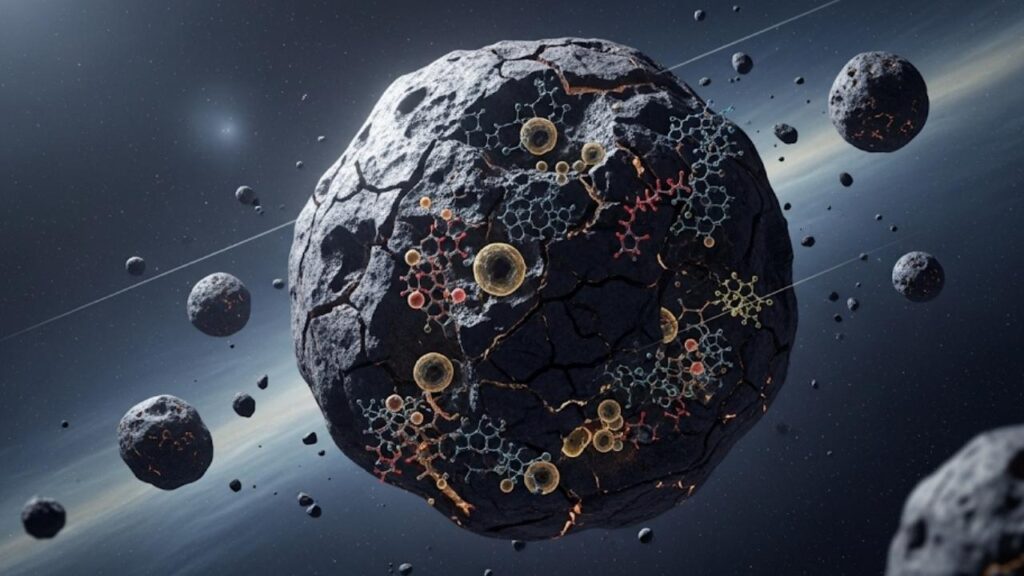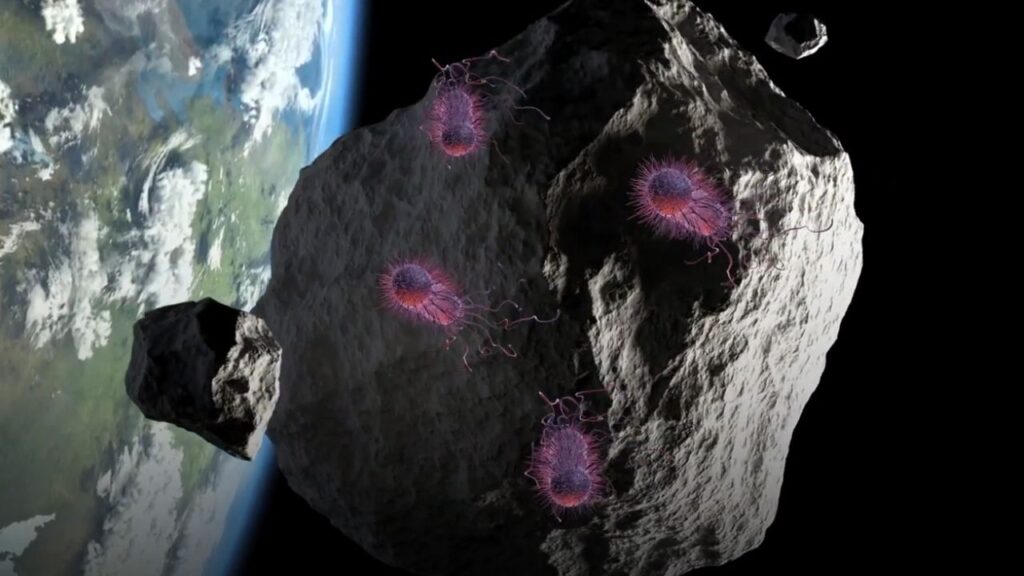Is it possible that life on Earth—every plant, animal, and human—started from tiny “seeds” traveling through space? This fascinating idea, called panspermia, is gaining strong scientific interest. Researchers are uncovering exciting clues suggesting that the building blocks of life arrived on Earth from space, challenging traditional ideas about how life began here.

Are we truly alone, or do we share a cosmic family tree with life elsewhere in the universe? In this detailed article, we will explore what science currently knows about panspermia, present the latest evidence, explain how this process could work, and answer common questions. Whether you’re a student, a curious reader, or a professional, this guide brings the cosmic story of life’s origins closer to home.
Table of Contents
Did Life Come From Outer Space?
| Key Data & Facts | Examples and References | Career/Professional Info |
|---|---|---|
| Life’s building blocks (amino acids, DNA bases) found in meteorites | NASA’s OSIRIS-REx mission (2025) found complex organics on asteroid Bennu | Astrobiologists, biochemists, planetary scientists |
| Panspermia is the idea that life travels across space on comets, dust | Experiments on the ISS (EXPOSE) demonstrated spores can survive space conditions | Exobiology, planetary science, meteorite research |
| No proof of full living organisms from space; mostly organic molecules | Meteorites carry complex organics but no confirmed living microbes from space | Microbiology, geology, planetary defense experts |
| Asteroid samples reveal salts and brines—possible “cradles” for chemistry | Bennu samples contain water-related minerals and organics | Laboratory analysts, planetary geology |
| Professional interest growing: labs designing detectors for panspermia | Harvard/MIT’s SETG project aims to detect DNA/RNA on Mars | Instrument designers, analytical chemists, Mars research |
Did life come from outer space? The answer from the latest research is that life’s ingredients are certainly cosmic—they have been found in asteroids, comets, and the dust between stars. While direct proof that living cells journeyed to Earth from space is yet to be found, the growing body of evidence makes it increasingly plausible that our planet was seeded with the molecular building blocks of life.
This discovery expands our understanding of life’s origins, suggesting a profound connection between Earth and the cosmos. It opens exciting avenues for professionals and enthusiasts alike to explore the deep question: Where—and how—did we truly come from?
What is Panspermia? Making Sense of a Cosmic Seed Theory

Panspermia means “seeds everywhere.” It is a scientific hypothesis suggesting life, or at least its essential ingredients, might be transported to Earth on space dust, meteorites, comets, or asteroid fragments. Instead of answering how life began, panspermia asks whether life could have arrived here from another place in the cosmos.
The idea is over a century old, first popularized by scientists like Svante Arrhenius in the early 1900s. Today, several varieties of panspermia are recognized:
- Radiopanspermia: Microscopic life travels vast distances propelled by radiation pressure.
- Lithopanspermia: Microorganisms hitch a ride inside rocks blasted off planets by asteroid impacts.
- Directed panspermia: Intelligent beings deliberately send lifeforms across space to seed life elsewhere.
Why Are Scientists Taking Panspermia Seriously Now?
For decades, panspermia was often dismissed as speculative. But new discoveries make the idea more credible:
- Life Appeared Very Early on Earth
Geological evidence shows life’s fingerprints dating back at least 4.28 billion years, soon after Earth cooled. Such rapid emergence is challenging to explain by Earth-based chemistry alone. - Complete DNA Building Blocks Found in Meteorites
Studies of meteorites now reveal all five nucleobases (the units forming DNA and RNA), plus a variety of amino acids and sugars—precisely the molecules used by life on Earth. - Asteroid Bennu Brings Water and Organics
NASA’s OSIRIS-REx mission returned samples containing organic molecules and salts associated with ancient liquid water, demonstrating that other bodies in the solar system carry life-enabling chemistry. - Lab and Space Experiments Show Survival Is Possible
Experiments aboard the International Space Station (ISS) exposed bacterial spores and plant seeds to space conditions. Many survived for over a year, suggesting microbes could endure space travel inside protective rocks. - Organic Molecules Are Found Across the Galaxy
Astronomers detect amino acids and complex organics in interstellar dust clouds and protoplanetary disks, indicating life’s basic chemistry may be common, not Earth-specific.
Did Life Itself Arrive from Space—or Just Its Ingredients?
While the building blocks of life are widespread in space, there remains no direct evidence that complete living cells or organisms came from elsewhere. The best-supported version, called pseudo-panspermia, proposes that organic molecules formed in space and were delivered to Earth, where life then originated.

The mystery of how inert molecules first became living cells on Earth remains unsolved. But the cosmic delivery of molecular ingredients is now a well-established fact, making panspermia a compelling theory about life’s origins.
How Panspermia Could Work: A Step-by-Step Guide
Step 1: Impact Launch
An asteroid or comet collides with a life-harboring planet (like early Mars), ejecting rocks into space. Some rocks trap dormant microbes or microbial spores.
Step 2: Journey Through Space
Embedded microbes survive the extreme cold, vacuum, and radiation of space, shielded inside the rocky debris. Experiments show some microbes can survive for years in such conditions.
Step 3: Entry and Landing on Earth
After drifting in space—possibly millions of years—the rock enters Earth’s atmosphere. The outer layers heat and burn away, but protected interiors can remain cool enough to protect microbes.
Step 4: Revival on Earth
Upon reaching a hospitable environment, water and chemistry on Earth might revive the dormant microbes or supply the final spark for life to emerge.
Practical Insights: What Panspermia Means for Science and Society
For Students and Curious Readers:
- The atoms and molecules in your body may have originated in the stars and have traveled the galaxy before settling on Earth.
- Understanding panspermia guides where to search for life beyond Earth — Mars, Jupiter’s moon Europa, and Saturn’s moon Enceladus are prime targets.
For Professionals:
- Astrobiologists develop instruments to test for DNA and organic compounds on other worlds.
- Planetary defense experts study meteorites to understand organic delivery risks and opportunities.
- Chemists and biologists simulate early Earth and space conditions to reconstruct life’s origins.
Practical Advice:
- Stay updated on NASA’s sample-return missions (like OSIRIS-REx and future Martian missions) for new discoveries.
- Join organizations like the International Society for Astrobiology or online courses in exobiology to deepen your understanding.
- Use credible databases such as NASA Astrobiology for ongoing research and peer-reviewed results.
Quantum Sensing: NASA Demonstrates Ultracold Quantum Sensor in Space
NASA’s SPHEREx Telescope Launches to Explore Universe’s Origins
FAQs About Did Life Come From Outer Space?
What is the current scientific consensus on panspermia?
Most scientists agree that panspermia plausibly explains the delivery of life’s molecular building blocks, but full living organisms arriving from space remain unproven. The theory is growing in respect but awaits direct evidence.
Have we ever found living microbes from space or space rocks?
No confirmed living extraterrestrial organisms have been found yet. Some Earth microbes can survive space conditions, and meteorites contain organic molecules, but no living cells from space are confirmed.
What are the most exciting discoveries supporting panspermia?
- Meteorites containing all nucleobases and complex organic molecules.
- NASA’s 2025 OSIRIS-REx asteroid Bennu samples revealing water-related minerals and organics.
- ISS experiments showing spores’ survival in space for years.
Is there a connection between Mars and Earth life?
Mars may have been habitable early in the solar system’s history and could have exchanged microbial life with Earth via asteroid impacts. Future missions aim to test this hypothesis directly by searching for Martian DNA/RNA.
How can life survive interplanetary space travel?
Some microbes form dormant spores with protective coatings, enabling them to withstand radiation, vacuum, and extreme temperatures. Rocks add further shielding, increasing survival odds.



















